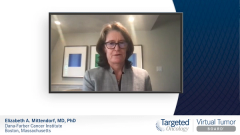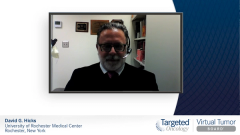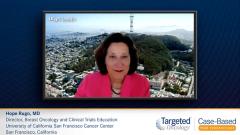
Case 3: Clinical Trial Inclusion in TNBC: Considerations and Barriers
The panel of experts in breast cancer discuss enrollment of patients with TNBC in clinical trials, including considerations and barriers.
Episodes in this series

Elizabeth A. Mittendorf, MD, PhD: That can be difficult. As you know, there’s the thinking about the trials, the medicine, and telling the patient—who you think would be such a candidate for the trial—they can’t go on it because their ER [estrogen receptor] is 2%.
David G. Hicks, MD: That’s such a subjective decision. It drives me a little crazy. I’ve become much stricter about my lower boundaries for calling something ER-positive.
Elizabeth A. Mittendorf, MD, PhD: One of the issues—Ruta, you alluded to it—is that you can call the study sponsor as much as you want. But in my experience, they answer their questions with the eye on the FDA. If the FDA is going to approve this for triple-negative breast cancer and then use those definitions that David and his pathology colleagues came up with. They’re not going to grant a lot of exceptions to have ER 1% or 2%. In that sense, unfortunately, it becomes a business decision. They’re not as likely, particularly for the registration trials.
Ruta Rao, MD: I agree. On the other side, it’s easy for us to prescribe endocrine therapy for these patients with low ER and then have a low threshold if they’re not tolerating it to not push them to take it. I see what you’re saying, David, about the medical oncologists not wanting to lose the opportunity to treat a patient. It does provide that. But I see it more in patients whom we can’t put on some trials.
Elizabeth A. Mittendorf, MD, PhD: Even though endocrine therapy is overall well tolerated, 1 of the things I’ve been known to see in my patients—as it relates to a recommendation for preoperative chemotherapy or even endocrine therapy—is that most of my patients don’t mind taking therapy if it’s going to help them. Nobody wants to take treatment that’s not going to benefit them, even if it has few adverse effects. There’s nothing that we do that has no adverse effects.
Ruta Rao, MD: I agree.
Elizabeth A. Mittendorf, MD, PhD: This was a very interesting case of a woman with triple-negative breast cancer who received preoperative systemic therapy. This gave us the opportunity to talk a little about how we assess these tumors pathologically at the time of surgical excision. I appreciated the opportunity to talk about the differences with prognosis as it relates to the extent of residual disease and how Ruta uses that information to potentially invoke CREATE-X. This was nice in that it allowed us to build on our first 2 cases, which were PD-L1 positive. For immunotherapy, BRCA negative—so no PARP inhibitors—sadly progressed but gave us an opportunity to display our enthusiasm for what sacituzumab has given us, with respect to our armamentarium in treating patients with metastatic triple-negative breast cancer.
If you look at the totality of the 3 cases—the first 1 showing the benefit of immunotherapy, the second showing the benefit of PARP inhibitors going after an adult tumor’s Achilles’ heel, and then this 1 showing the benefit of sacituzumab in later lines of therapy—we wouldn’t have had this conversation even as recently as 18 months ago. It’s a really exciting time to be in the field: thinking about the ways to advance the care and thinking of the critical questions of what’s next. We asked that about each case.
I appreciate both of you joining. I don’t want to leave without giving you an opportunity for final thoughts you might want to impart upon our audience. David, any take-home messages you want to give the group?
David G. Hicks, MD: Sure. I want to thank both of you. I’ve enjoyed the opportunity to participate in this discussion. It’s always interesting. I started my career in internal medicine and switched to pathology. People asked me, “Don’t you miss taking care of patients?” I said, “I’ve substituted that with taking care of clinicians who take care of patients.”
Elizabeth A. Mittendorf, MD, PhD: That’s probably much harder.
David G. Hicks, MD: The head of our breast center, who’s a breast surgeon, calls me her BFF [best friend forever], so I think I’m doing a good job. But triple-negative breast cancer, I agree, was a wastebasket 18 months ago. It’s defined by what it’s not. It’s not ER-positive. It’s not PR [progesterone receptor]–positive. It’s not HER2 [human epidermal growth factor receptor 2]–positive. We think of it as a single disease. But when we dig down and look at the biology, it’s probably many diseases at the molecular level. It’s exciting to see these patients being teased out and identified for new therapeutics. We’re going to see more of that as we go forward.
We’ve encountered a couple of lower-grade breast cancers that were very apocrine under the microscope and that were triple-negative. The comment from the clinicians was that they weren’t acting like triple-negative breast cancers. They didn’t look like the typical basal breast cancer, and we’ve started doing antigen receptors on them. They light up with antigen receptor. This luminal androgen receptor triple-negative breast cancer is a whole other beast that we can potentially exploit for that androgen receptor. As a pathologist, I’m excited. It gives me more opportunities to interact with clinicians and to help you guys make better decisions. I’m grateful for that.
Elizabeth A. Mittendorf, MD, PhD: Well, we know that Jennifer Pietenpol’s data from many years ago now suggest that, in fact, there are probably 7 subtypes of triple-negative breast cancer. There arguably could be more than that. I’m reminded of when I was a surgical oncology fellow, and I was on my sarcoma rotation. I was like, “There are 37 histologies. How am I going to remember all this?” But before I retire—which is still a bit in the future—we will probably be able to better differentiate what we call triple-negative for the reasons that you mentioned.
Ruta, I want your final comments. Before you summarize some of your take-home messages, what’s going on with targeting the androgen receptor? I’m drawing this out because I’m enjoying the evening.
Ruta Rao, MD: No problem. It’s great that David brought that up. We have some trials that have been published looking at targeting the androgen receptor and having that as an option. To David’s point, it’s important for the pathologist to recognize that this might be a triple-negative breast cancer—although under the microscope, it may look like 1 of these apocrine tumors—and then to test it for the androgen receptor. If we can help identify those patients, we can continue to target them.
Elizabeth A. Mittendorf, MD, PhD: Ruta, what are your take-home messages for our audience?
Ruta Rao, MD: I’ve really enjoyed this. I’ve learned a lot. To echo with what you both said, it’s really exciting that we could even spend this long talking about triple-negative breast cancer and the different targeted therapies we can offer these patients: immunotherapy, PARP inhibitors, and sacituzumab. As a medical oncologist, it just gives me hope for our patients.
Elizabeth A. Mittendorf, MD, PhD: Thank you both for your input. It really has been a lot of fun. This wasn’t really designed for me to be entertained, but I have been. Thank you very much for the lively and informative discussion. To our viewing audience, thank you for joining us for this Targeted Oncology™ Virtual Tumor Board® presentation. We hope today’s discussion was valuable to you and a good use of your time. We hope you acquired some practical knowledge. Ruta, you gave a lot of practical knowledge with respect to using these agents that everyone can take back to the clinic.
Transcript edited for clarity.












































